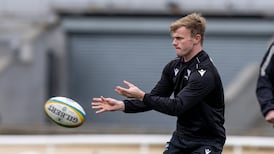The last time Tiger Woods topped the US PGA by season’s end was in 2013. In the 60 rounds he played he took 4,193 shots and in doing so won $8,553,439. Way down at 100th in the same money list sat Ted Potter Jnr. He played one extra round that PGA season and managed to earn a season total of $829,770; that’s $7,723,669 in the difference.
We can delve deep into the figures but the most alarming statistic of that 2013 season was the shot per round difference between Potter and Woods. Astonishingly, Woods played an average 69.88 shots per round with Potter just behind him on 71; that’s a miserable 1.12 shots per round. Or for easy maths, that’s one shot per round that propels you from 100th earning $829,770 to first and $8,553,439. The difference?
I sense that Joe Schmidt understands this difference and now with back-to-back Championships the players do too. Last Friday I noted that Charles R. Swindol is convinced life is 10 per cent what happens to him and 90 per cent how he reacts to it.
Wales forced us much too far into the 90 per cent reaction ratio where the loss of key lineouts and referee decisions had a huge impact on the outcome.
Considering the ebb and flow of elite fixtures coming our way all players and management will have learnt how to react; this is an enormous positive lesson from our loss to Wales.
Odds stacked
That all said, much of Schmidt’s modus operandi is to stay in the 10 per cent of controllables. This can be seen in his different gameplan at international level compared to his time in Leinster.
He has tightened up much of the play, keeping the odds stacked in his favour and hence the results. It stuttered somewhat in Wales as they, too, had a plan. Last week we witnessed an unfettering and tries flowed. This, of course, is not Schmidt’s building block.
The best window into Schmidt's rugby is the Irish team's methodology around the 200-plus breakdowns in each match and what happens if you don't conform to the picture he requires. Only international number eights David Denton and Jamie Heaslip out-carried Paul O'Connell in Edinburgh.
Clearly all three have different carrying styles where O’Connell’s is a straight-up carry. This allied to rare offloads affords the support runner an excellent picture in preparation of the clearout; here lies the 1.12 shots per round.
Three arrivals
The first three arrivals to attacking rucks this
Six Nations
makes for interesting tactical clarity. That O’Connell topped this chart followed by Devin Toner and Peter O’Mahony speaks volumes for their work ethic and grit. That they could top the
Six Nations
charts also places the ruck relatively close to where they were.
A more expansive game may prove too far for even the mighty O’Connell to consistently reach. Hence the one out target is one that possibly maximised our excellence at the breakdown. But the picture our ball carrier gave O’Connell, Toner and O’Mahony was clear – affording a precise, accurate outcome.
All Six Nations I've been highlighting the value of the five-second rule in airtime box kick and breakdown recycle. This is especially crucial against England where slowing their recycle dampens their midfield hugely. But with Sam Warburton the lead on the first three arrivals to defending rucks Ireland got suckered into playing to Welsh strengths.
It appears that my five- second breakdown rule needs to be reduced to 3 seconds. Tiger Woods dominated Potter into 100th place and 9.7 per cent of his prize money by one shot a round. Ireland are now doing this through their style of play; one out rucking, super ball carrier picture and quality breakdown clearouts followed by an accurate kick chase return based on the fastest Six Nations recycle; 2.9 seconds versus Wales’ 3.6 seconds. That’s 0.7 per breakdown.
With 260 rucks in that Wales-Ireland game with half a second differential there was over three minutes difference in a game where the ball is in play an average of 37 minutes per game; three Championship winning minutes.
Unburdened by the possibility of a potential offload from an Irish ball carrier the support runner can get into the ‘recycle’ position much earlier. What then does the ball carrier have to present?
The answer possibly lies in the selection of Luke Fitzgerald over Simon Zebo. Fitzgerald runs brilliant lines and dances laterally on arriving into traffic and then powers out cleanly. Zebo equally brilliant, takes it further into traffic and engages earlier before bumping and spinning out of the tackle before powering on. Hence when both are tackled they subsequently present a different picture to the support runner.
Zebo can get into a dog fight, and depending on the physique and determination of the tackler, may get into awkward positions on the deck. This can prove a challenge to the support runner creating poor body shape and feet placement, threatening entry beyond the gate which risks loss of the ball or worse a penalty.
Fitzgerald, by virtue of his different technique, is in a better place to dominate the tackle regardless of the capability of the defender, making life much easier for the support runner.
Safe exit
That ball placement target affords an accurate clearout; clearing any opposition debris particularly from the side of the ruck where the ball is moving. This in turn affords the Irish scrumhalf a safe exit sweeping the same way. Or as O’Connell discovered on 4:06min, an open door to carry through for his try. The difference? 0.7 seconds per ruck or for Ted Potter Jnr 1.12 shots per round and $7,723,669 by season’s end!
liamtoland@yahoo.com












